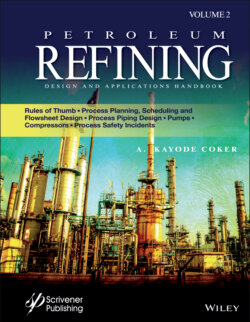Читать книгу Petroleum Refining Design and Applications Handbook - A. Kayode Coker - Страница 17
COOLING TOWERS
Оглавление1 1. Water in contact with air under adiabatic conditions eventually cools to the wet bulb temperature.
2 2. In commercial units, 90% of saturation of the air is feasible.
3 3. Relative cooling tower size is sensitive to the difference between the exit and the wet bulb temperatures:∆T, °F51525Relative volume2.41.00.55
4 4. Tower fill is of a highly open structure so as to minimize pressure drop, which is in standard practice a maximum of 497.6 Pa (2 in. of water).
5 5. Water circulation rate is 48.9–195.7 L/min m2 (1–4 gpm/ft2) and air rate is 6344–8784 kg/h m2 (1300–1800 lb/h ft2) or 1.52–2.03 m/s (300–400 ft/min).
6 6. Chimney-assisted natural draft towers are hyperboloidally shaped because they have greater strength for a given thickness; a tower 76.2 m (250 ft) high has concrete walls 127–152.4 mm (5–6 in.) thick. The enlarge cross section at the top aids in dispersion of exit humid air into the atmosphere.
7 7. Countercurrent-induced draft towers are the most common in process industries. They are able to cool water within 2°F of the wet bulb.
8 8. Evaporation losses are 1% of the circulation for every 10°F of cooling range. Windage or drift losses of mechanical draft towers are 0.1–0.3% Blowdown of 2.5–3.0% of the circulation is necessary to prevent excessive salt buildup.
